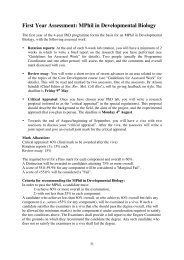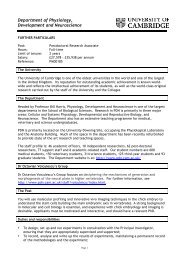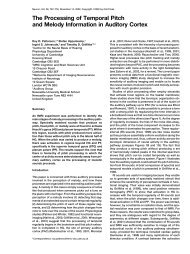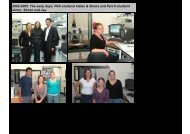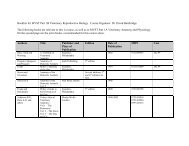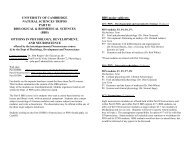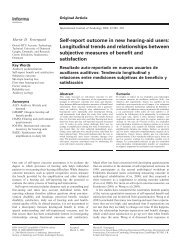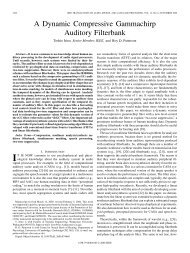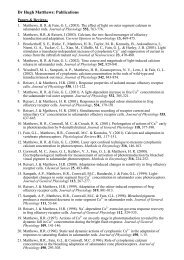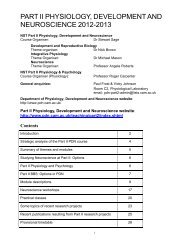FRIDAY MORNING, 20 MAY 2005 REGENCY E, 8:30 A.M. TO 12:00 ...
FRIDAY MORNING, 20 MAY 2005 REGENCY E, 8:30 A.M. TO 12:00 ...
FRIDAY MORNING, 20 MAY 2005 REGENCY E, 8:30 A.M. TO 12:00 ...
You also want an ePaper? Increase the reach of your titles
YUMPU automatically turns print PDFs into web optimized ePapers that Google loves.
for listeners to correctly detect the occurrence of the BIC increased rapidly.<br />
This elevation in the duration threshold was faster under the<br />
headphone-stimulation condition than the loudspeaker-stimulation condition.<br />
Also, the listeners reaction time in response to the BIC but not that to<br />
a comparable silent gap elongated quickly with the increase in the intersound<br />
delay from 1 to 8 ms. Thus the auditory memory of fine structures<br />
fades rapidly after the sound waves are received. Work supported by<br />
MSTC and NSERCC.<br />
5aPP19. Evidence for a cancellation mechanism in perceptual<br />
segregation by differences in fundamental frequency. John F. Culling,<br />
Gareth M. Linsmith, and Tracy L. Caller School of Psych., Cardiff Univ.,<br />
Tower Bldg., Park Pl. Cardiff, CF10 3AT, UK<br />
Identification of target speech material is better when it differs in fundamental<br />
frequency (F0) from interfering speech material. Two experiments<br />
tested the idea that this effect is mediated by a cancellation process<br />
that perceptually removes sound on one F0. Expt. 1 used monotonized<br />
target speech at 1<strong>12</strong>.5 Hz F0 against two monotonized interferers. The<br />
F0s of the interferers were either both 1<strong>12</strong>.5 Hz, both <strong>12</strong>6 Hz, or 1<strong>00</strong> and<br />
<strong>12</strong>6 Hz. Speech reception thresholds SRTs were about 3.5 dB lower<br />
when the two interferers shared a <strong>12</strong>6 Hz F0 than in the other two conditions,<br />
which differed by only 0.3 dB. These results are consistent with a<br />
cancellation mechanism that is able to remove sounds at only a single F0.<br />
Expt. 2 replicated and extended Expt. 1, testing whether the results were<br />
affected by the allocation of the target and interferers to particular F0s.<br />
When all sentences shared a common F0, SRTs were now 1–1.5 dB<br />
higher than when they were all different. However, all 4 SRTs for interferers<br />
sharing the same F0 differing from that of the target by 2 or 4<br />
semitones were lower than all three of the SRTs for interferers with independent<br />
F0s.<br />
5aPP<strong>20</strong>. Effects of high-frequency amplification and training on<br />
impaired-listeners’ ability to discriminate redundant cues. Blas<br />
Espinoza-Varas, Shelagh Bowman-Edmundson, and Hyunsook Jang<br />
Commun. Sci. and Disord., Univ. Oklahoma Health Sci. Ctr., Oklahoma<br />
City, OK 73190<br />
This paper examines effects of high-frequency amplification and training<br />
on the ability to discriminate redundant duration increments added<br />
simultaneously to the low (L) and high (H) frequency component of<br />
two-component complexes. The frequency of L 5<strong>00</strong> or 1<strong>00</strong>0 Hz, 80 ms<br />
and H <strong>20</strong><strong>00</strong> or 3<strong>12</strong>7 Hz, 60 ms was chosen so as to stimulate simultaneously<br />
normal- and impaired-sensitivity regions of high-frequency sensorineural<br />
patients. The 3I/2AFC task displayed a standard followed by<br />
two comparisons. Duration increments in L, H, or both (tL, tH,ortLH),<br />
occurred randomly in comparison 1 or 2, and listeners had to decide which<br />
had an increment. The training stages were: 1 no H amplification, with<br />
L35, H5 dB SL and tL, tH, and tLH; 2 H amplification, same as<br />
before but with H35 dB SL; 3 H amplification and tH discrimination<br />
training, same as stage 2, but with tH only and H in isolation or together<br />
with L; and 4 retest of stage 2, post tH discrimination training. Only in<br />
stage 4 did redundancy yield a significant improvement in overall discrimination<br />
accuracy; amplification alone yielded little improvement.<br />
5aPP21. Wideband reflectance in normal and otosclerotic ears. Navid<br />
Shahnaz and Karin Bork Univ. of British Columbia, School of Audiol. &<br />
Speech Sci., 5804 Fairview Ave., Vancouver, BC, Canada V6T 1Z3,<br />
nshahnaz@audiospeech.ubc.ca<br />
For years immittance has been used in order to help diagnose middle<br />
ear pathologies. Specifically, multi-frequency tympanometry MFT is<br />
able to relate information regarding the mechano-acoustical characteristics<br />
of the middle ear system. In the past two decades a new method of middle<br />
ear measurement, wideband reflectance WBR, has been introduced.<br />
WBR is the ratio of energy reflected from the surfaces of the ear canal and<br />
middle ear on its way to the cochlea in relation to the energy that reaches<br />
the surface, or incident energy. This ratio is known as energy reflectance.<br />
This paper adds to the limited normative data available, as well as explores<br />
whether these normative data have a clinical utility in the diagnosis<br />
of otosclerosis. Descriptive statistics were gathered from 62 115 ears<br />
Caucasian normal hearing adults as well as in seven patients seven ears<br />
with otosclerosis. All of the otosclerotic patients in this study deviated<br />
from the normative values on at least one of the four WBR parameters of<br />
power absorption, admittance, susceptance, or conductance even when<br />
their MFT results were within normal limits. Although only seven patients<br />
were tested, these results provided evidence in favor of the utility of WBR<br />
for diagnosis of otosclerosis.<br />
5aPP22. Sensitivity to combined frequency and amplitude speech cues<br />
by cochlear implant users. Eric W. Healy, Cheryl F. Rogers, and Allen<br />
A. Montgomery Dept. of Commun. Sci. and Disord., Arnold School of<br />
Public Health, Univ. of South Carolina, Columbia, SC 29<strong>20</strong>8,<br />
ewh@sc.edu<br />
Although a considerable amount of work has been directed toward<br />
examining the sensitivity of the cochlear implant CI user to various<br />
acoustic cues, less has examined the ability to combine cues. The sensitivity<br />
to concurrent cues was examined using an adaptive 3I-2AFC paradigm.<br />
Stimuli were synthesized three-syllable words having middle syllables<br />
that possessed an increase in fundamental frequency, amplitude or<br />
both. Sensitivity to increments in the individual cues was first measured<br />
for five subjects with a CI and five age-matched controls. These DLs were<br />
then used to equate sensitivity to the two cues and create stimuli having<br />
concurrent increments. It was found that the presence of the two cues<br />
reduced the mean DL to half that of either cue alone, for both groups of<br />
subjects. Thus, this combination of cues is similar across groups and simply<br />
additive. Individual differences in the ability of CI users to combine<br />
cues were more strongly predictive of performance on speech recognition<br />
tests than was sensitivity to either cue alone. These results have implications<br />
for the perception of the multiplicity of speech cues. Work supported<br />
by NIDCD.<br />
5aPP23. Recognition of vowels that have been spectrally warped<br />
according to the frequency map for the spiral ganglion. Peter S.<br />
Popolo and Christoper W. Turner Dept. of Speech Pathol. and Audiol.,<br />
119 WJSHC, The Univ. of Iowa, Iowa City, IA 52242,<br />
peter-popolo@uiowa.edu<br />
The purpose of this study was to explore the effect of a specific spectral<br />
warping on vowel recognition in cochlear implant users. The warping<br />
was designed to simulate the misalignment of frequency-to-place stimulation<br />
which occurs if the spiral ganglion cells are electrically stimulated<br />
instead of the eighth-nerve dendrites in the organ of Corti. Simulated<br />
CIS-processed vowel stimuli were generated in which the analysis and<br />
carrier band center frequencies were shifted according to the projection of<br />
the spiral ganglion cells onto the organ of Corti, derived from published<br />
data A. Kawano, H. L. Seldon, and G. C. Clark, Ann. Otol. Rhinol.<br />
Laryngol. 105, 701–709 1996. Similar spectral warping was applied to<br />
unprocessed vowel stimuli. Listening experiments were conducted in<br />
which normal hearing subjects were presented with four types of stimuli:<br />
unprocessed-unwarped, processed-unwarped, unprocessed-warped, and<br />
processed-warped. For each condition, performance was allowed to stabilize<br />
over repeated trials with feedback, to allow for learning. Vowel recognition<br />
scores averaged across listeners were drastically reduced for the<br />
warped stimuli, regardless of whether the stimuli were CIS-processed or<br />
not. The combination of spectral warping and reduced spectral resolution<br />
resulted in the poorest intelligibility scores. These results may have implications<br />
for the design of frequency-to-place maps in cochlear implants.<br />
26<strong>00</strong> J. Acoust. Soc. Am., Vol. 117, No. 4, Pt. 2, April <strong>20</strong>05 149th Meeting: Acoustical Society of America 26<strong>00</strong>



